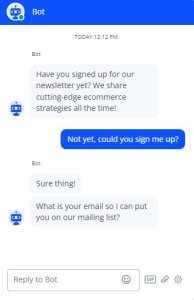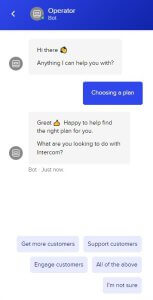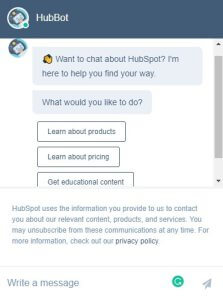The Ultimate Guide to Conversational Marketing (+Examples)

Contents
Emerging automation technologies are changing the way businesses communicate with their customers and among each other. They also enable businesses to do more with less, keeping them competitive with ten times bigger companies.
Conversational marketing is the perfect example of how companies tackle the scalability challenges they experience. It’s the ideal approach to quickly respond to thousands of customers without having them wait in line.
That kind of benefit was only available to enterprises with huge customer support departments. In this guide, we’re going to cover all the essentials of conversational marketing, including:
- What is it?
- What are the benefits of using it?
- How to implement it?
Keep reading to see what are the top platforms for creating automated communication. You’ll also find a couple of examples from brands that have successfully implemented it in their marketing approach.
What is conversational marketing?
Conversational marketing is an automated form of communication that businesses are increasingly employing. The core of the technology relies on chatbots, which simulate human-like conversations.
Their effectiveness and practicality have made them an important element in business-customer communication and the strategic planning around it. Businesses discover key customer details, so they have all the necessary information to continue the contact when the conversations switch to the support agent.
Integration plays a vital role in conversational marketing, as storing data in CRMs can help with improving customer satisfaction and increasing customer loyalty. That’s why apps like Talkdesk come with integration support and its AI system to help use conversational marketing.
In the end, conversational marketing helps businesses provide outstanding service throughout different parts of the lead funnel.
Benefits of using conversational marketing
Conversational marketing is appealing due to its cost-effectiveness, among other things. Companies are consistently looking for ways to reduce costs, and implementing a chatbot is a great way to achieve that goal.
But that’s only the tip of the iceberg. While saving costs is important, businesses get many other benefits. Let’s explore them in more detail.
Providing immediate service
As technology keeps moving forward, so do the customers’ expectations. The days when people were fine with sending an email and waiting for a reply for a day or two are long gone. Many customers expect immediate and high-quality service.
Once a customer reaches out to you, they need to get an immediate response with a solution to their challenge. If there’s a need for further assistance, they’re minutes away from human contact.
The best part is that they don’t have to leave the website or the app. Customers can reach out, get help and continue where they’ve left off while using your platform.
Additionally, chatbots are available at all times. It’s irrelevant whether your customer is local or in a different time zone. They’ll be able to get in touch and get the answer they’re looking for. Besides being available 24/7, chatbots are available everywhere. You can make them work:
- In your app or website
- Social media
- Messaging app
Your availability on multiple platforms is convenient, as you can match the expectations of your customers.
Learning more about customers
Depending on how you set up your artificial communication, you can learn more about your customers through automated interaction. Use the data to create cross-selling opportunities in the future. Understand what are the most common pain points and work on improving your product.
What’s more, with a higher count of interactions, you’ll be able to create better conversation flows. That’ll result in more human-like interaction in the future.
Building powerful relationships
Customer loyalty is the primary goal for businesses in all industries. Businesses can grow easily with an increasing number of returning clients. High-quality customer service is one of the powerful ways to increase customer loyalty, and conversational marketing greatly helps you achieve this.
From the moment a user lands on your website, a simple pop-up in the form of a chat shows that you value their visit and you’re there for them. Visitors will feel valued as they browse your website, especially if your recommendation with help is what they need.
Providing value is going to be more challenging at first. That’s because you’ll be able to anticipate only a couple of dialogue scenarios. However, when visitors start interacting with your chatbot, you’ll get the much-needed data to help you make better predictions in the future. You’ll be able to continue working on various dialogues to service a broader range of communication scenarios.
For example, if you’re running a SaaS company and a potential client is on your plans page, you can use a live chat pop-up to help them pick the right plan. These minor interactions can positively affect conversion rates.
Capturing more leads
The goal of every inbound marketing strategy is to get more leads for a business. While the right approach will get more people to come to your site, you need to ensure you’re making the proper steps towards high conversion rates.
That’s where an effective chatbot comes into play. It’s the perfect tool to establish communication with clients. What makes it so perfect? The fact that it’s there 24/7. Whether you’re in a meeting, at home, or sleeping, the chatbot helps to generate more leads for your company.
With the help of advanced tools like an AI chatbot builder, businesses can easily create and customize automated conversational interfaces. This enables seamless interactions with customers, providing real-time assistance, and even facilitating transactions. Thus, they can streamline customer support processes, and ultimately generate more leads.
Scalability
Despite having top-class customer support agents, there’s nothing you can do when thousands of requests pop up. If you’re running an eCommerce store with tens of thousands of customers, the only way to offer assistance to everyone is through a chatbot.
They are the first line of defense and will allow you to help customers who need more assistance with minor issues. The chatbots can forward links to knowledge base articles. That will drive the percentage of self-service higher. That means that customers will get the solutions from the resources on your blog without needing support agent assistance.
With that in mind, no matter how big your company becomes, your team will be able to handle thousands of requests without sacrificing the quality of their service.
How to implement conversational marketing
Benefits show that it’s not a matter of whether you need a conversational marketing tool but how you should implement it. The process is not that complex. Still, it requires careful planning every step of the way.
1. Are all your tools compatible?
First, you have to check whether all the platforms you’re planning to use can work together. For example, if you’re using WooCommerce, BigCommerce or Magento platforms for your eCommerce website, check whether they play along with the conversational marketing tool you’re planning to use.
Simply head over to the platform’s website and see whether the integrations work. If not, opt for one that you can implement seamlessly.
2. Plan out your buyer’s journey
Before you start using a tool, you need to figure out where to place them on your website. But to do that, you first have to map out your buyer’s journey.
As you already have the data, take a look at how the users navigate your website. Detect their pain points and challenges. For example, if you notice a high cart abandonment rate, that means that there’s a problem with that page that needs addressing.
After you detect pages where people are experiencing challenges, turn them into candidates for conversational marketing pop-ups. Once you take this step, you can move on to the hardest part of chatbots creation, the dialogue design.
3. Create complex automated dialogues
The biggest challenge of making an effective chatbot remains the human element. You need to design dialogues that sound like a real person. That way, the users are more likely to interact with the chatbot and continue using it in the future.
Creating dialogue scripts is best performed in teams. Multiple people can better design an artificial conversation, as they can better think of the potential questions and sentences that a person would ask. But there’s a more manageable approach to follow.
As you’ll see in examples later, many brands opt to start conversations by offering choices to customers. The chatbot takes the initiative of driving the conversation in a specific direction.
This process takes the most time and needs continuous improvement. Monitor how the customers are interacting with your chatbots and make improvements to the dialogues. Make them more human, effective and professional.
4. Add automated follow-ups
As previously mentioned, using data collection is a benefit that lets you build even closer relationships with your clients. Based on the collected data, you can create automated email follow-ups. It’s another opportunity to request feedback from your customer.
You can practically make any kind of follow-up that makes sense. For example, here’s a great cross-selling approach. The data shows that customers often buy several products together. If you sell one of those, your automation can suggest to the user to buy another product.
To avoid being pushy, the automation can send an email a month later, a reminder that if the customer needs a related product, you have it in stock.
5. Deploy, analyze user behavior and improve
Don’t think that once you set up your chatbot, you can lay back and relax. You’ll have to put in a lot of effort to make it effective as intended. Analyze every interaction and measure how effective it was. Are the pop-ups in the right place? Does the chatbot help solve challenges?
If not, what can you do about it? Keep asking these questions and make updates that help improve customer experience.
Available platforms
Numerous companies are competing in the conversational marketing game. Before you make your pick, you have to examine what they have to offer carefully. Here are some of the major companies to consider.
- Intercom
- Drift
- Tidio
Each of these platforms supports a broad range of integrations. They are user-friendly and don’t require any coding knowledge. You can set them up and have them running quickly.
Examples of conversational marketing
Brands use different approaches to benefit from conversational marketing tools. A couple of examples are:
- Improving cart abandonment rates
- Welcoming messages that offer something for free
- Leaving website feedback
- Returning visitor message
- Growing newsletter
It depends on the creativity of the marketing team and the goals of the company. Here’s how some brands did it on their websites:
1. BigCommerce

Once you land on BigCommerce’s website, you’ll see a chat bubble in the right bottom corner. It’s a polite call to action to sign up for the BigCommerce newsletter. Once you open up the chat, you can click to show interest, when the chatbot requests your email address.
If you’re looking for a way to grow your mailing list, you can follow BigCommerce’s example.
2. Intercom

While you’re browsing available plans on the Intercom’s site, this message will pop up in the bottom right corner as well. One of the options is “Choosing a plan” which is logical since you’re on that page. Once you click it, the chatbot presents you with multiple options.
The example shows how easy it is to help the customer pick the right plan for their company.
3. Hubspot

Once you get on Hubspot’s website, the brand immediately wants to give you a tour with their conversational marketing approach. As the brand offers a broad range of services, it wants to take the visitor on a journey and present what that particular visitor might need.
That’s perfect for those who don’t want to roam the website searching for information. Customers can get what they need right here in the chat box with a couple of clicks.
4. OptinMonster

OptinMonster wants to offer free value to its returning customers. It’s a great way to improve conversions. Plus, it’s a personalized offer that visitors will enjoy. That’s a great sales approach that opens communication with customers who’ve seen your services multiple times.
5. Allthingsvinyl

Offering a promotion is another option that you can pick. Once you get to the All Things Vinyl website, you get offered a promo code. If you were planning to purchase, that’s a great incentive to persuade you to buy a bit more since you have a discount.
Concluding thoughts
Hopefully, you now know which steps to take when you’re implementing a conversational marketing tool. Follow the examples of other brands and see what would work best in your use case.
The point to remember is that you have to be thorough with the whole process. Creating a human-like automated chat can be challenging. With enough effort, you can enjoy the benefits that will elevate your business to a different level. You’ll be able to service thousands of customers without growing your support team.





